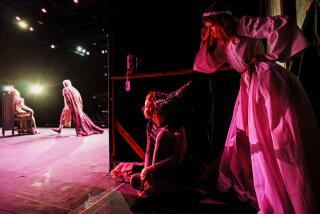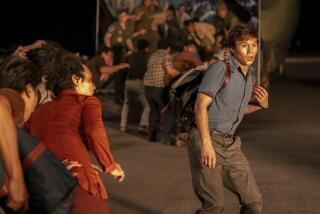A Most Civil War
There will be more noise than a cat fight in a machine shop and more smoke than in a ‘40s gangster movie when the Civil War arrives Sunday at Ft. Tejon. Several hundred spectators are expected to watch Yankees and Confederates bring back the bad ol’ days of 1861-65 so the War Between the States can continue in endless overtime.
Really just a picnic with guns, where men actually enjoy shopping and compliment one another on their clothes, Civil War reenacting provides a colorful glimpse of the single most important event in American history. And there are really no bad guys. Everyone is an American; patriots or traitors are in the eye of the beholder.
Ft. Tejon was an actual military outpost built in 1854, and a few of the original buildings still stand. The U.S. Army troops stationed there had the less-than-glamorous job of protecting the settlers and the Native Americans from each other. In 1861, the soldiers packed up to go east, where the action was.
If not at Ft. Tejon--which hosts reenactments on the third Sunday of each month through October--there’s a Civil War battle going on somewhere in Southern California each month. A much more elaborate reenactment, perhaps the largest mock battle in Southern California this year, will take place May 22-23 at the Sepulveda Dam Recreation Area in the San Fernando Valley.
On Sunday at Tejon, there will be three battles, each featuring cavalry and artillery, not to mention scores of marching infantry, all wearing colorful uniforms and really bad shoes called brogans. Contemporary stagings of Civil War battles have all the mystery of professional wrestling, with comparable levels of acting ability and choreography but more noise. Soldiers “die” when their side is supposed to lose or when their commander orders them to “take some hits.” It’s sort of a we-win, they-win scenario, which goes a long way toward explaining why the Civil War yet rages.
So who would want to get involved in this blast from the past? Lots of people, as it turns out. More than 100,000 are “reenactors” nationwide, mostly in the East where all the real marching, fighting and dying took place.
Though armed and dangerous, reenactors are not ultra-right-wing militia types by any means, but rather Civil War buffs in expensive uniforms who enjoy living history. The 6th Wisconsin of the Iron Brigade, some of whom will be fighting this weekend, is a fairly typical group. Its local ranks include an economist, an FBI agent, a truck driver, a writer, a mailman, a bouncer, small-businessmen, an optometrist and a few students.
Tom Atkins, an aerospace worker from Lancaster and commander of the 8th Louisiana, heard Dixie calling when he accidentally discovered an event at Ft. Tejon one day in 1991.
“I knew right away that this would be my hobby. I became a rebel because I’ve always rooted for the underdog. To me, the Yankees are conformists, and they don’t seem to have as much fun in camp. The best thing is teaching people, which is also the worst thing because you wouldn’t believe some of the ignorant questions we get,” Atkins said. “My father was a lifelong teacher, and by doing this, I think I’m paying back my father.”
For spectators, reenactments are a way to watch the action without being in a real war zone. No one will wind up in the notorious Andersonville prison, where Union soldiers died by the thousands. There will be no amputations with a dull saw after two sips of cheap brandy. Also, dysentery, typhoid fever and measles, which killed far more Civil War soldiers than combat, will be mercifully absent.
Generally, when the first cannon goes off at a reenactment, all the birds fly over the mountains, several of the nearby car alarms go off and many of the babies start to cry. A mild uproar, the Civil War is not. Everything is designed to look and sound the same as the real thing--except for the use of real bullets.
Black powder is used in the cannons and rifle muskets but no cannon balls and no Minie balls for obvious reasons. Everything sounds real, looks real and makes lots of real smoke, but no one dies--at least for very long. No one gets upset if his only son is killed; he’ll make a miraculous recovery a few minutes later when the bugler plays a screechy version of “Recall,” signifying the end of the battle. That’s when all the soldiers stand up, take a bow, march back to camp, roll more rounds, drink lots of water and wait for the next battle.
There was plenty of real dying in the real Civil War, of course. The battles were horrendous and they happened one after another for four years. The 600,000 soldiers killed is more than in all other American wars combined. The War Between the States was the first conflict to combine modern weaponry and old-fashioned tactics, resulting in massive casualties unrivaled until World War I.
During the Civil War the idea was to direct concentrated firepower upon the enemy until they ran or were shredded by .58-caliber greeting cards. Thus, attackers who marched in large formations shoulder to shoulder were hard to miss as a rifle musket was accurate up to several hundred yards, and cannons much farther than that. There were more than 23,000 casualties at the battle of Antietam in 1862--the bloodiest day in American history--more than triple the 6,600 wounded, killed or captured on D-day. After the three-day battle of Gettysburg, 53,000 casualties were reported.
Battles will be shorter at Tejon, usually about 30 minutes each. In between, there will be plenty of period music, living history presentations and tours of the camps. Soldiers try to explain the way it was to those who might have slept through history class. (Oh, and the president himself generally shows up at these events. Abe Lincoln, of course. He likes to talk.)
The Civil War these days is not just a guy thing, but a family affair. While some guys do use the weekends as an escape from their home lives, many bring their kids and wives along. Women in period attire portray nurses or members of the Sanitary Commission--a group of civilian volunteers who tried to improve the health of the troops--while some dress as men and carry a musket. The former are more popular at the dances usually held on Saturday night.
On Sunday morning, chaplains try to cajole the heavily armed sinners to the church service. Even little kids can use their aggression in a socially acceptable way as drummer boys. Combatants must be at least 16, unlike in the real war, where there was no age limit on who could carry a gun.
Thus, for all intents and purposes, it’s 1863 again and everyone is supposed to stay in a 19th century persona until the public leaves. Anything not of the period--such as coolers full of beer or Twinkies--are labeled “farb” and are hidden from public view. Water, straw and wood are usually the only amenities provided, and sometimes it’s really cold at night.
Civil War reenacting began shortly after the war itself ended and has gained in popularity, especially since the Civil War centennial and the success of films such as “Glory” and “Gettysburg” as well as Ken Burns’ 11-hour “Civil War” documentary series on PBS.
For example, the 1993 movie “Gettysburg” featured only about 20 actors but more than 5,000 reenactors as extras--all historically correct down to the smallest detail. Well, several of the reenactors were too fat--real soldiers routinely suffered from a diet of salted pork and coffee--but that’s another story.
A new recruit can expect to spend anywhere from $200 to maybe $1,000 for a cool uniform and those nasty, heavy brogans, depending upon one’s unit of choice. The soldiers get their gear and supplies by mail or at the events themselves from Civil War merchants called “sutlers,” several of whom count bargains as a complete stranger. Sutlers sell everything necessary for warfare, including black powder, percussion caps, uniforms, weapons and accouterments. The rebs obviously are cheaper to equip as no two dress alike, looking a lot like shoddy vagrants outside a secondhand store. That’s probably why there’s usually more Johnny Rebs at a reenactment than Billy Yanks.
The greatest expense for the reenactor is the rifle musket--an Enfield or a Springfield costs around $400. The rifles are fully functional replicas, many of them made in Italy, while American-made weapons cost substantially more to make equal noise.
To Have Fun and Educate People
In a reenactment unit, everyone begins as a private; some stay that way. Making rank is slow, depending on things like attendance and Civil War knowledge. When a unit gets so many members, they’re entitled to a corporal, then a sergeant and so on. This prevents everyone from showing up as generals Grant or Lee, which would be really funny about once.
People enlist for a variety of reasons. Several are simply interested in the Civil War. One such is Jon Reed of Whittier, captain of the 6th Wisconsin and a 20-year veteran reenactor.
“Ever since I read Civil War books as a kid, I always knew the Confederacy was wrong, everything that they were doing. Owning other people just isn’t right. I do this just to have fun and also to educate people. The best part of a reenactment is the camaraderie--just sitting around the campfire at night.”
Others join because of their family. Neil Morrison, major of the 69th New York of the Irish Brigade, began reenacting the Napoleonic Wars while stationed with the U.S. Army in Europe, a place with plenty of wars to reenact. One of Morrison’s relatives was a drummer boy in 1815 at Waterloo whose son, David Morrison, became the colonel of the 79th New York, a regiment made up of Scottish immigrants.
“Originally, I wanted to start a 79th New York regiment, but the kilt alone costs $350, and you can’t really use it for anything else. I wanted to stay Celtic, so I started an Irish Brigade regiment, which has a standard uniform.”
Others have more visceral reasons for becoming a Civil War reenactor.
“Your daddy’s a lizard!” yelled Pvt. Sean Willadsen of the 2nd Wisconsin, a good Union man, at an overweight, bulletproof reb. After shooting the offending grayback, who finally took a hit, he shouted, “Now you’re a good reb!”
(BEGIN TEXT OF INFOBOX / INFOGRAPHIC)
The ’99 Civil War Campaign
Sunday--Fort Tejon, three miles past Lebec on Highway 5. 10 a.m., noon and 2 p.m. $5; children, $3; under 6, free. (805) 248-6692.
May 22-23--Sepulveda Dam Recreation Area, Van Nuys. (805) 496-7736.
May 29-31--Roaring Camp, Felton (near Santa Cruz). (408) 335-4484.
June 5-6--Sun City, near Lake Elsinore off I-15. (760) 253-2094 or (714) 533-6212.
June 5-6--Follows Camp, on East Fork Road in Azusa. (661) 821-6624 or (805) 288-1515.
June 12-13--Riley’s Farm, just outside Beaumont on Oak Glen Road. (909) 790-2364.
June 20--Fort Tejon.
July 3,4--Follows Camp.
July 10-11--Fort MacArthur, at Gaffey Street and Leavenworth Drive in San Pedro. (310) 548-7705.
July 18--Fort Tejon.
Aug. 14-15--Fort Tejon.
Sept. 4-5--Central Park, on Golden West Avenue between the 405 and the beach, in Huntington Beach. (714) 969-9108.
Sept. 19--Fort Tejon.
Sept. 25-26--Moreno Valley. (760) 253-2094 or (714) 533-6212.
Oct. 2-3--Kearney Park, Fresno.
Oct. 9-10--Irvine Regional Park, 1 Irvine Park Road, Orange. (714) 633-8074.
Oct. 17--Fort Tejon.
Oct. 23-24--Thousand Oaks, in the field next to the Civic Arts Plaza. (805) 496-7736.
Nov. 13-14--Riley’s Farm.
More to Read
Sign up for The Wild
We’ll help you find the best places to hike, bike and run, as well as the perfect silent spots for meditation and yoga.
You may occasionally receive promotional content from the Los Angeles Times.






